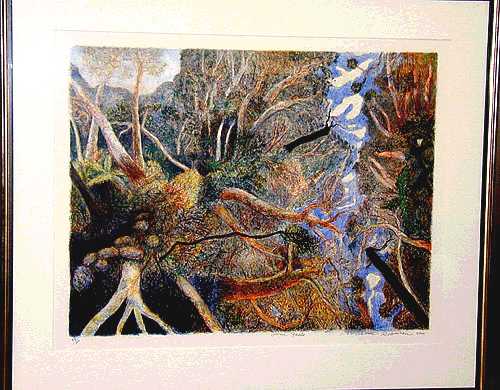William Robinson , Twin Falls
Twin Falls by William Robinson
WILLIAM ROBINSON (Australian, 1936-)
Twin Falls 2000 Lithograph Edition: 89/100 62cm x 78cm Acquired 2001 109632 |
|
Biography:
William Robinson is regarded as one of Australia’s leading contemporary artists, best known for his skewed perspectives of Australian landscapes and whimsical portraits.
With an emphasis on the humorous and the absurd, Robinson’s paintings explore the meaning of life and his place within it. His paintings evoke a sense of wonder at our daily surroundings, and he broadens the notion of landscape to encompass a fluctuating environment of rainforest and ocean, ground and sky, luminosity and darkness.
Born in Brisbane in 1936 Robinson began his career in art as a teacher at the Central Technical College. In 1970 he moved to Birkdale and domestic life on his small farm provided much of the subject matter for his early works. In 1984 he moved to a farm in sub-tropical Beechmont, and a decade later moved to the coastal town Kingscliff in New South Wales. In Beechmont and Kingcliff Robinson’s paintings began to explore the atmosphere and spirit of both inland sub-tropical landscapes and seascapes while incorporating elements of the surreal and fantastic, such as The Rainforest and his Creation series.[1]
Throughout the 1990s, in successive shows at the Ray Hughes Gallery in Sydney, Robinson broke new ground. Robinson won the Archibald Prize in 1987 and 1995 for his self-portraits and continues to paint from his home in Brisbane.
Artwork:
The present work is an example of Robinson’s mature expressionist style. It is a carefully observed study of the rainforest in which the soft light from the sun casts a warm orange glow across the tree tops and water. The scene draws upon his experiences living in the lush rainforest environment of Southeast Queensland and Robinson has characteristically employed multiple viewpoints on a large scale to depict the vast terrain and place the viewer simultaneously within and above the landscape. Using very small brushes Robinson has cleverly portrayed the transition from light to darkness, and condensed time and space in the process.
Bibliography:
Earls, N., William Robinson: A New Perspective, Queensland University of Technology, Brisbane, 2018
Fern, L., William Robinson, Craftsman House, 1995


